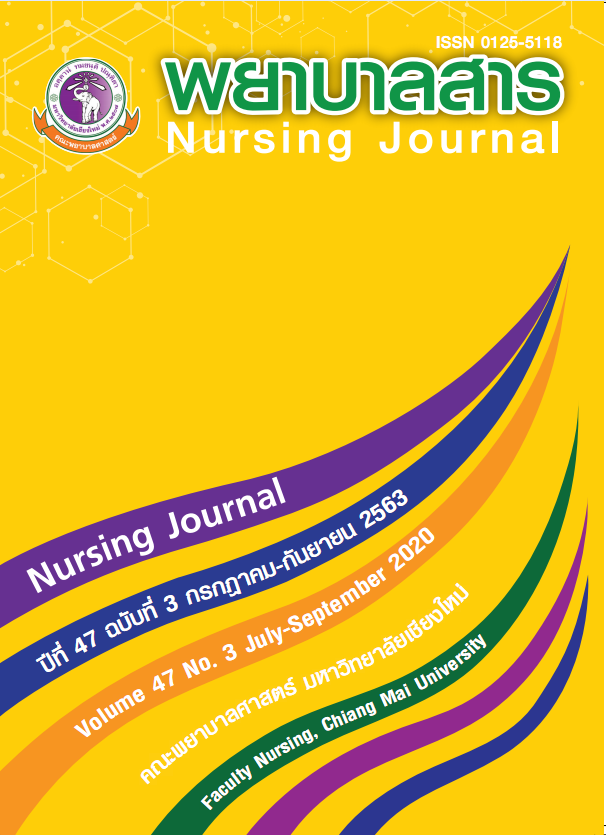Barriers to readiness for hospital discharge in liver cancer and cholangiocarcinoma patients post invasive percutaneous transhepatic biliary drainage: Perspectives of Health Care Provider
Keywords:
liver cancer and cholangiocarcinoma patients, readiness for hospital discharge, health care provider, barriersAbstract
Health care providers are responsible for adequate preparation of patients for discharge from the hospital. This research aimed to describe perception of health care providers on barriers to readiness for hospital discharge in liver cancer and cholangiocarcinoma patients post invasive percutaneous transhepatic biliary drainage. Design of study was descriptive qualitative research. Qualified participants were recruited by purposive sampling included 10 healthcare providers. Data was collected by using in depth interview. Data was analyzed by using content analysis. The finding indicated that perception of health care providers on barriers to readiness for hospital discharge in liver cancer and cholangiocarcinoma patients post invasive percutaneous transhepatic biliary drainage revealed that into four themes 1) unclear of readiness to discharge system 2) heavy workload on staff 3) limitation of patients’ perception and 4) lack of clear teaching media and simple. The recommendations were health care providers should assess and identify patients’ need in readiness to hospital discharge for achieve truly need and explore evaluation of readiness approach to hospital discharge. All of this will support patients pass through life period in hospital discharge to home efficiently.
References
Duangmala, M., & Boonyaleepan, S. (2010). Self-care behaviors of cholangiocarcinoma patients after percutaneous transhepatic biliary drainage. Medical Journal of Yasothon Hospital, 12(2), 135 – 145.
Galvin, E. C., Wills, T., & Coffey, A. (2017). Readiness for hospital discharge: A concept analysis. Journal of advanced nursing, 73(11), 2547-2557. doi:10.1111/jan.13324
Graneheim, U. H., & Lundman, B. (2004). Qualitative content analysis in nursing research: concepts, procedures and measures to achieve trustworthiness. Nurse education today, 24(2), 105-112.
Hesselink, G., Flink, M., Olsson, M., Barach, P., Dudzik-Urbaniak, E., Orrego, C., ... & Vernooij-Dassen, M. (2012). Are patients discharged with care? A qualitative study of perceptions and experiences of patients, family members and care providers. BMJ quality & safety, 21(Suppl 1), i39-i49.
Horwitz, L. I., Moriarty, J. P., Chen, C., Fogerty, R. L., Brewster, U. C., Kanade, S., ... & Krumholz, H. M. (2013). Quality of discharge practices and patient understanding at an academic medical center. JAMA internal medicine, 173(18), 1715-1722. doi:10.1001/jamainternmed.2013.9318
Information and Technology Division, National Cancer Institute.(2015).Hospital base cancer registry annual report 2014.Bangkok : Pornsup Printing Co., LTD.
Information and Technology Division, National Cancer Institute.(2016).Hospital base cancer registry annual report 2015.Bangkok : Pornsup Printing Co., LTD.
Information and Technology Division, National Cancer Institute.(2017).Hospital base cancer registry annual report 2016.Bangkok : Pornsup Printing Co., LTD.
Kable, A., Baker, A., Pond, D., Southgate, E., Turner, A., & Levi, C. (2019). Health professionals’ perspectives on the discharge process and continuity of care for stroke survivors discharged home in regional Australia: A qualitative, descriptive study. Nursing & health sciences, 21(2), 253-261. doi:10.1111/nhs.12590
Khunyodying, D. (2016). Caring of patients after percutaneous transhepatic biliary drainage. Retrieved September 5, 2018 from https://www.lpch.go.th/lpch/uploads/20160218100125834995.pdf
Korttila, K. (1991). Anaesthesia for ambulatory surgery: Firm definitions of “home readiness” needed. Annals of Medicine, 23(6), 635-636.
Kunthakhu, S., Watthanakitkrileart, D, Pongthavornkamol, K & Dumavibhat, C. (2009). Factors Influencing Readiness for Hospital Discharge in Acute Myocardial Infarction Patients. J Nurs Sci, 27(2), 83 - 91.
Lincoln, Y. S., & Guba, E. G. (1985). Naturalistic inquiry. Newbury Park: SAGE.
Pinelli, V. A., Papp, K. K., & Gonzalo, J. D. (2015). Interprofessional communication patterns during patient discharges: A social network analysis. Journal of general internal medicine, 30(9), 1299-1306. doi:10.1007/s11606-015-3415-2
Punyagariyagorn, S. (2013). Factors Related to Preventive Behaviors Affecting Complications of Cholangiocarcinoma’s Patients after Percutaneous Transhepatic Biliary Drainage. Nursing Journal of Ministry of Public Health, 23(1),70 – 79.
Ragavan, M. V., Svec, D., & Shieh, L. (2017). Barriers to timely discharge from the general medicine service at an academic teaching hospital. Postgraduate Medical Journal, 93(1103), 528-533. doi:10.1136/postgradmedj-2016-134529
Weiss, M. E., & Piacentine, L. B. (2006). Psychometric properties of the Readiness for Hospital Discharge Scale. Journal of Nursing Measurement, 14(3), 163-180.
Weiss, M. E., Piacentine, L. B., Lokken, L., Ancona, J., Archer, J., Gresser, S., ... & Vega-Stromberg, T. (2007). Perceived readiness for hospital discharge in adult medical-surgical patients. Clinical Nurse Specialist, 21(1), 31-42.
Weiss, M. E., Yakusheva, O., & Bobay, K. L. (2011). Quality and cost analysis of nurse staffing, discharge preparation, and postdischarge utilization. Health services research, 46(5), 1473-1494. doi:10.1111/j.1475-6773.2011.01267.x
Wong, E. L., Yam, C. H., Cheung, A. W., Leung, M. C., Chan, F. W., Wong, F. Y., & Yeoh, E. K. (2011). Barriers to effective discharge planning: A qualitative study investigating the perspectives of frontline healthcare professionals. BMC health services research, 11(1), 242. doi:10.1186/1472-6963-11-242.
Downloads
Published
How to Cite
Issue
Section
License
บทความที่ได้รับการตีพิมพ์เป็นลิขสิทธิ์ของวารสารพยาบาลสาร
ข้อความที่ปรากฏในบทความแต่ละเรื่องในวารสารวิชาการเล่มนี้เป็นความคิดเห็นส่วนตัวของผู้เขียนแต่ละท่านไม่เกี่ยวข้องกับมหาวิทยาลัยเชียงใหม่ และคณาจารย์ท่านอื่นๆในมหาวิทยาลัยฯ แต่อย่างใด ความรับผิดชอบองค์ประกอบทั้งหมดของบทความแต่ละเรื่องเป็นของผู้เขียนแต่ละท่าน หากมีความผิดพลาดใด ๆ ผู้เขียนแต่ละท่านจะรับผิดชอบบทความของตนเองแต่ผู้เดียว






